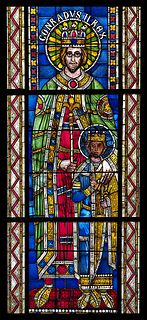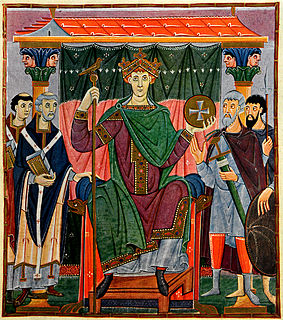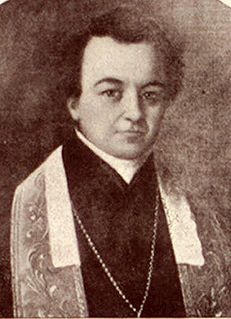| Aribo | |
|---|---|
| Archbishop of Mainz | |
| Church | Catholic Church |
| Diocese | Electorate of Mainz |
| In office | 1021–1031 |
| Personal details | |
| Died | 1031 |
Aribo (died 1031) was the Archbishop of Mainz from 1021 until his death. He was Primate of Germany during the succession of Conrad II.

Conrad II, also known as Conrad the Elder and Conrad the Salic, was Emperor of the Holy Roman Empire from 1027 until his death in 1039. The founder of the Salian dynasty of emperors, Conrad also served as King of Germany from 1024, King of Italy from 1026, and King of Burgundy from 1033.
Aribo disputed with the Diocese of Hildesheim the jurisdictional right over Gandersheim Abbey, but Pope Benedict VIII found in favour of Hildesheim, a ruling which Aribo further disputed and ignored, without however denying the pope's right to judge. Aribo also grieved the cathedral chapter of the Diocese of Worms after they elected and the new king appointed a bishop without his (Aribo's) approval in 1025. Aribo also disapproved of Conrad's marriage to Gisela on the basis of consanguinity, challenging its legality.

Gandersheim Abbey is a former house of secular canonesses (Frauenstift) in the present town of Bad Gandersheim in Lower Saxony, Germany. It was founded in 852 by Duke Liudolf of Saxony, progenitor of the Liudolfing or Ottonian dynasty, whose rich endowments ensured its stability and prosperity.

Pope Benedict VIII reigned from 18 May 1012 to his death in 1024. He was born Theophylactus to the noble family of the counts of Tusculum, descended from Theophylact, Count of Tusculum, like his predecessor Pope Benedict VII (973–974). Horace Mann considered him "...one of the few popes of the Middle Ages who was at once powerful at home and great abroad."

Gisela of Burgundy, a member of the royal Elder House of Welf, was Duchess of Bavaria from about 972 to 976 and again from 985 to 995, by her marriage with Duke Henry the Wrangler. She was the mother of Emperor Henry II.
Aribo expanded the economy of Thuringia by minting coinage at Erfurt, the oldest market and trading centre in the province.

Thuringia, officially the Free State of Thuringia, is a state of Germany.

Erfurt is the capital and largest city in the state of Thuringia, central Germany.
Aribo had consecrated Saint Gotthard as bishop of Hildesheim on December 2, 1022. [1]

Saint Gotthard, also known as Gothard or Godehard the Bishop, was a German bishop venerated as a saint.











